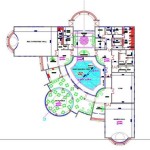Big House Plantation: A Step Back in Time
Nestled amidst the rolling hills of Virginia, Big House Plantation stands as a testament to the grandeur and complexity of the antebellum South. This historic property, open to the public for tours and events, offers a unique glimpse into a bygone era and serves as a reminder of the intertwined histories of slavery, agriculture, and wealth in the United States.
A Grand Residence
The centerpiece of the plantation is the Big House, an imposing two-story mansion built in the Federal style. With its white-columned portico and symmetrical facade, the house exudes an air of opulence and power. The interior is equally impressive, boasting high ceilings, intricate moldings, and period furnishings. The home served as the residence of the plantation's owner, Colonel John Tayloe III, and his family.
Agricultural Empire
Big House Plantation was not merely a residence but also a thriving agricultural enterprise. The plantation encompassed over 2,000 acres of land, on which enslaved Africans labored to produce tobacco, wheat, and other crops. The plantation's success was built on the exploitation of human lives, a legacy that cannot be overlooked.
Lives of the Enslaved
Enslaved people played a central role in the operation of Big House Plantation. They lived in small cabins on the outskirts of the plantation and worked long hours in the fields. Their lives were marked by hardship and oppression, and many died prematurely due to disease, overwork, or punishment. The plantation's slave quarters have been reconstructed and are open for visitors to explore, providing a glimpse into the harsh realities of their existence.
Preservation and Interpretation
In the 20th century, Big House Plantation was acquired by the National Park Service and established as a historic site. The park service has undertaken extensive restoration efforts to preserve the mansion, outbuildings, and grounds. Guided tours are available daily, led by knowledgeable rangers who share the history of the plantation from multiple perspectives, including the experiences of the enslaved.
Educational and Cultural Importance
Big House Plantation is not only a historical landmark but also a significant educational resource. It provides an opportunity for visitors to learn about the complexities of American history and the enduring legacy of slavery. The plantation also hosts special events and educational programs that explore themes of race, class, and social justice.
Visiting Big House Plantation
Big House Plantation is located in Stafford County, Virginia, approximately an hour south of Washington, D.C. Guided tours are offered daily, and admission fees apply. Visitors may also explore the grounds on their own or participate in special events and educational programs. A visit to Big House Plantation is a thought-provoking and enriching experience that offers a deeper understanding of a pivotal period in American history.

Visit Plantation Homes Of The South Audley Travel Us

Datei The Big House Whitney Plantation Historic District 2024 Jpg Wikipedia
The Big House On A Great Southern Plantation Nypl Digital Collections

Plantation Exploration

Descendants Of Slaves Seek Shelter From Ida In A Plantation S Big House Npr

Travel The Whitney Plantation Outside New Orleans Shows Reality Of Slavery Orange County Register

File Whitney Plantation June 2024 Big House Can See Through Center Jpg Wikimedia Commons

10 Most Beautiful Historic Southern Plantation Homes You Can Visit Wicked Good Travel Tips

Plantation Homes Recall Bygone Era Of Splendor Suffering

Three Days In Plantation Country Deep South








